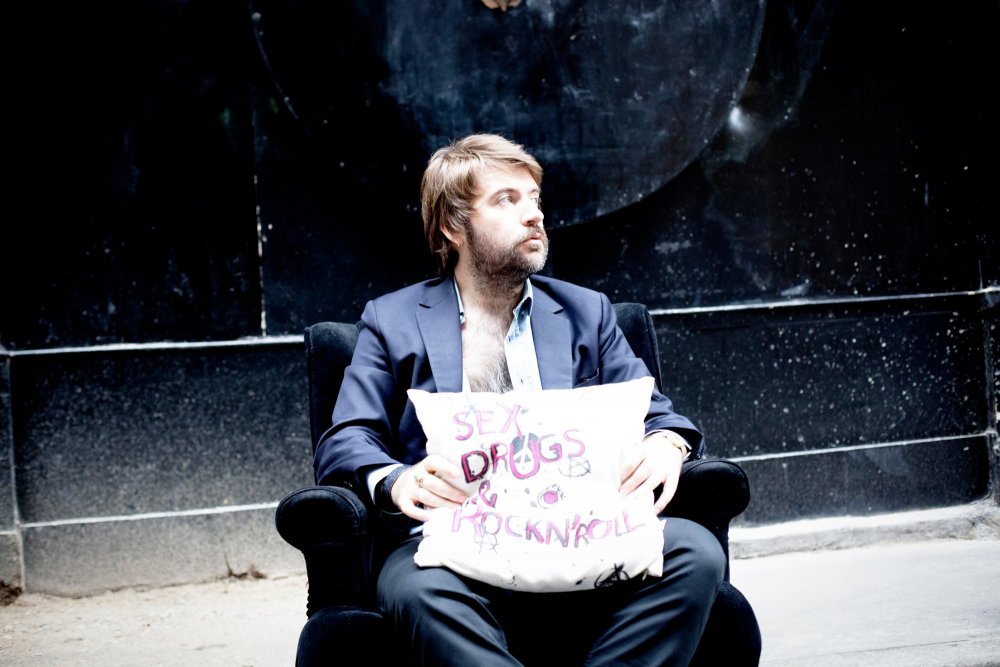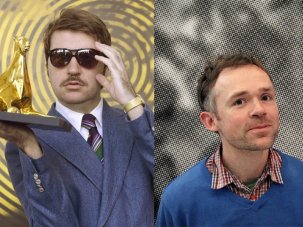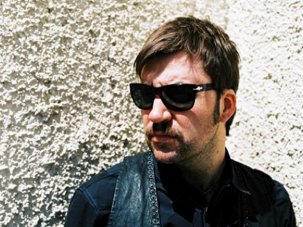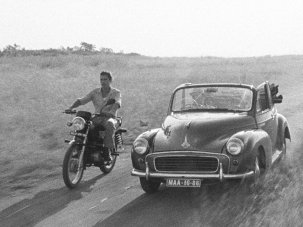If new movie masterpieces are proclaimed at each and every major film festival each and every year, the notable absence of adventurous, exciting and otherwise transgressive cinema amongst those lauded should inspire us to question not only the terms we use to describe films but also the standards to which we hold them.
Story of My Death (Història de la meva mort) is now available on DVD from Second Run. The DVD will be reviewed in the forthcoming September 2015 issue of Sight & Sound.
Catalan filmmaker Albert Serra, a transcendental minimalist who wields his camera like only a handful of fellow feature-film digital adventurers – among them Pedro Costa, David Lynch and Michael Mann – is one of the few who produces work that truly creates a new encounter with the audience. His radically stripped-down, voluptuously shaggy adaptations of canonical writing – Cervantes in Honour of the Knights (2003), the Bible in Birdsong (2008) and in his most recent film, Story of My Death (2013), a mash-up of Casanova’s memoirs and Dracula’s legend – have a completely unique aura to them not of telling a story or adapting a book, but of people being and inviting us into their presence. Using non-professional actors and elliptical, undramatic narratives, through a deep grounding in physical bodies but a loftiness in light and texture, these films are full of immanence, of people being in time, in the land. Despite these three major works – between which he has produced less strong but equally ambitious experimentations – having historical settings, the domain of costume dramas and re-creation, none are of history: each moment seems utterly present, its tender, awkward humanity telling more than so much talk, action and money spent in the vast majority of films.
I caught up with Albert Serra a year after his film’s debut at the Locarno Film Festival, where it took home the Golden Leopard, the festival’s top prize. The discussion understandably did not linger on this film now of the past, but on Serra’s filmmaking practice and of its future.
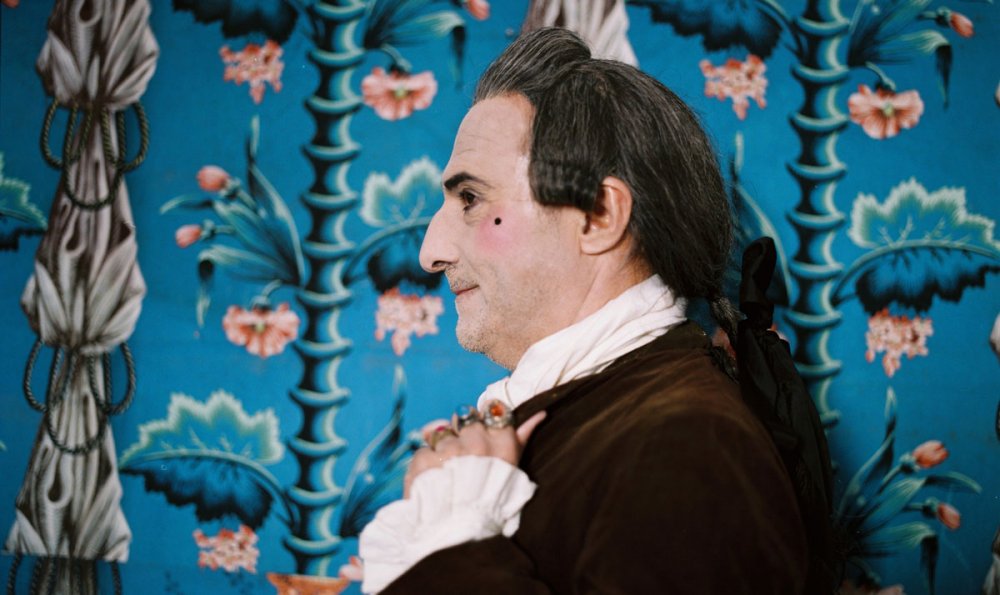
The Story of My Death (Història de la meva mort, 2013)
It’s been a year since you’ve premiered Story of My Death. Is it something that still lives with you, or have you moved on to another place?
My real goal is a new film, a feature film, with all the complexity, the richness, all the narrative, the conceptual approach I have developed in my previous films, but here I am taking it farther. It’s about the contemporary art world. It will be called I Am an Artist. It’s about a young artist in 2014 or 2015 trying to work. Trying to live in this quite extravagant world of contemporary art.
I hope it will be done. Nowadays you never know, with the financing. It’s very hard in Spain. I mean, I can do it in a certain way, I work with people who will work for free. We also want to shoot this way: I like it, our shootings are very stressful. I like the violence of the set.
Watching your films, including Story of My Death, I got the opposite sense, that all was relaxed.
Well, it’s relaxing in the sense that it can change your life! For example, during the last movie six people changed couples during the shooting. Four of them with people inside the shooting, two with those without. They were couples, people living together! But in the middle of the shooting, or after the shooting they changed partners. They live in a dream they believe is real. So they always wait for the next film to change again. I have two of them that in every shooting they change partners. People are waiting for me.
The way that you shoot your films, the work involved on the set behind the scenes seems its own microcosm.
Yes. You have to deal with that, it’s in the heart of… you cannot experience change through the shooting if it’s not a real shooting. Warhol was a great influence; what Chelsea Girls [1966] is about is manipulation – but in the good sense. Okay, everybody hated Warhol because he was the manipulator and was the only one rich at the end and all the other were poor.
At the same time, you feel, with Chelsea Girls for example, it’s like looking at life in the people around, looking at life. The most passive, most quiet and calm guy is really glowing with life instead. Life, more life, means more passion, more action. The essence of what we’re doing here in the world.
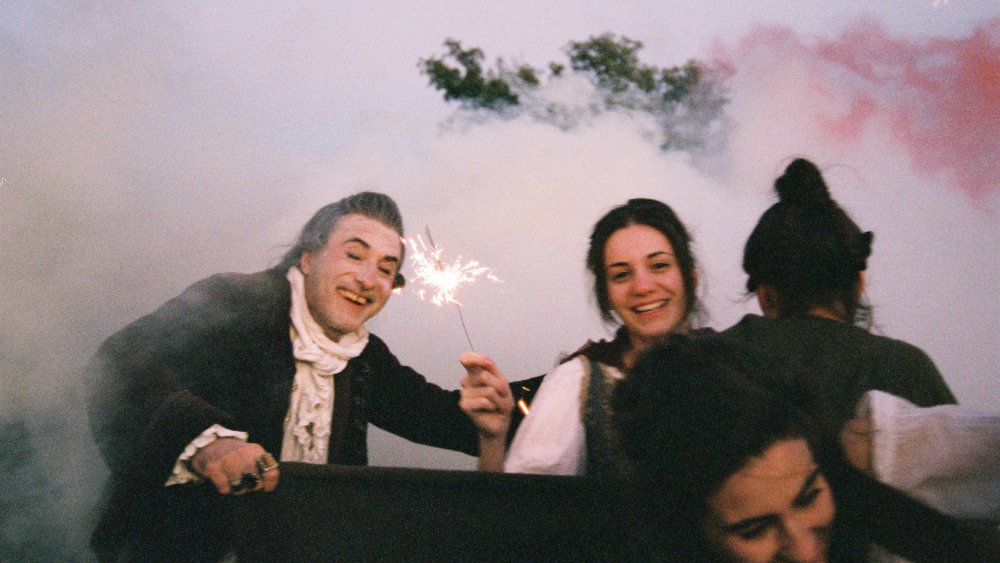
The Story of My Death (Història de la meva mort, 2013)
But the details and subtleties always arrive in the shooting. Details, for me, have to grow up like a small flower. You cultivate a big field and there are small flowers that appeal spontaneously.
The making of the film is a catalyst for life.
Yes, art is that. It’s a beautiful parallelism, a beautiful example of how art should be. I always say what really changed my life was art. Writers – Marcel Proust, Cervantes – real writers; real filmmakers – Warhol; maybe Dalí. These people changed my life and made me take decisions in my real life to become the person I am now. I think this is very important.
This example is more linking of real life with the shooting, but it’s a good example to show that art, filmmaking has consequences in real life. I’d like to believe that art is an improvement of our lives. It was an idea I had a few months ago: What do you think is better for the world, that in all the cinemas there is a [Jean-Marie] Straub film, or a [Steven] Spielberg film? What do you think would create more goodness for humanity? Straub film in all the cinemas, for sure, we all agree! I discovered in the end that what I do or what certain filmmakers do is important for the goodness of humanity. The main goal of the new film – it was already in the previous films, but here I want to put it more extreme – the mix of the serious approach with the ludic, the playful side, the parody, the irony – you know? Really put it in a natural and extreme way.
The comedy of your films often comes out of the discrepancy between the technique and the setting. I’d be very curious to see this applied to a film set ‘now’ and in the real world.
Yes. I think it’s quite unique, this approach. Usually you make a comedy or take a serious approach. But to mix both? To have a real spiritual, deep approach and have parody at the same time? This is really typical in the 20th century avant-garde, the playful side of Dada and Surrealism, blah blah blah. And in Pop Art. Now it’s a little bit lost. People, filmmakers are now so obsessed with their own career that they’re scared to put in things that could in the end be against the serious, critical approval of the film.
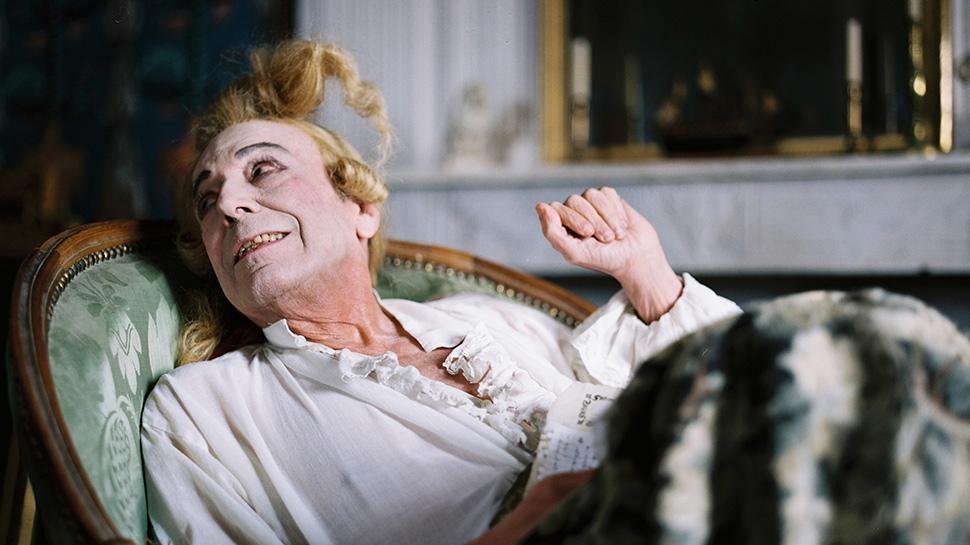
The Story of My Death (Història de la meva mort, 2013)
But I like this risky thing. And I think the art world is interesting, because it already has this point: you see something you can say “this is fucking grotesque”, but at the same time there are still people there with the true faith in art. Jeff Koons is an example. He really believes in what he is doing, that it is art. In some sense he’s like Don Quixote, but mixed with the grotesque side. This is the point of departure. It deals with the complexities nowadays of what is fake, what is true, where it ends. The real artist: where it starts. The purity of the artist compared to the purity of society, the dealers, the galleries. Already you see some of this in my previous work…
You said shooting was like cultivating a field to find flowers, details. Would you say these appear not just in the shooting but in the editing?
Maybe, maybe. Then you can control a little bit, look at the big field and discover the small flowers. But I discovered recently in my process – and it was my obsession in The Story of My Death and I think it will grow in the next films – that I wanted to make something new, and not repeat myself and blah blah blah… I had the paranoia of cliché. Cliché in general, and cliché of myself.
So I started spontaneously and then slowly and more consciously to develop a strategy to always work against my previous ideas, in all phases of the film. I have an idea of a concept and when I go to write the script, I go against the ideas I had in mind before. When I shoot, I take all the ideas I thought were good in the script, and shoot against that. And then, when I edit, always against the content of what was good and beautiful during the shooting. And in post-production, we go against what we shot.
This film was [shot in the aspect ratio] 4:3 originally, it’s a beautiful thing. In the middle of the shooting – by chance, also, always – I had some problems with the cameras. I never look at the images in the cameras during the shooting – never. I don’t check the monitors, the computer, nothing, nothing, nothing.
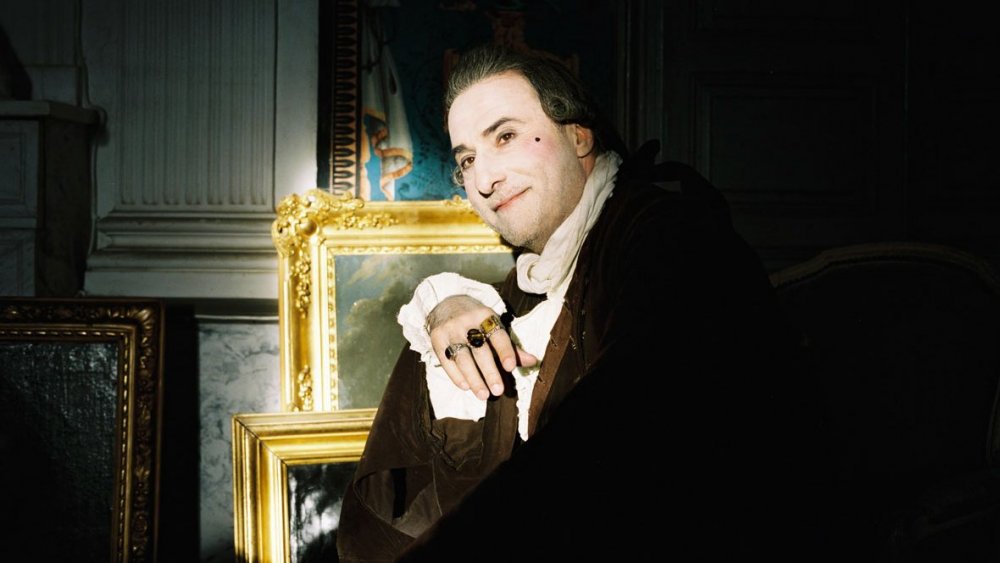
The Story of My Death (Història de la meva mort, 2013)
You set the frame and then you are done?
Yeah. Sometimes if the cinematographer – because I always use several cameras – asks, “Do you like this or this?” I will check it. Or sometimes I can predict I’ll have problems during the editing so I say “Well, let’s do it this way, because if not…” Because I edit the films myself there is a real deep knowledge of what you have to do during the shooting to get the possibilities during the edit.
So, in the middle of the shooting we checked for the texture of the camera problems and I said “I don’t like this 4:3.” It was the same time Miguel Gomes was shooting Tabu in 4:3, and there was another film shot in 4:3, so I said “Fuck! I hate this,” for this and technical reasons. And by chance a friend of mine was working with the computer and put on the CinemaScope frame, and “Oooh, I like it!”
We didn’t say anything to the cinematographer, who kept composing the film in 4:3. Then at the end, when the film was edited and finished, one or two hours before sending the film to the lab – because it was transferred to 35mm – we re-composed all the shots. It’s interesting. If you transform 4:3 to 1.66:1 essentially you have the same image. You can improve a little bit or maybe destroy a little bit. But [reframing] from 4:3 to CinemaScope, you lose 40 per cent of the image. It’s a new image, a new concept of what was shot. It’s against, against. You can do it in a hard way. You can cut 40 per cent of the image. Or in the mix in the sound; I really work hard on the sound.
Can you be hard on actors?
Actors are a good example. I develop a hate for the actors. “Loving actors” – sure, because I work with people I like; but in order not to stay in the cliché, I’ve started to develop a hate for actors during the shooting. Because if you love, it’s already underlining what is already there. This humanistic approach – which I don’t like – shooting actors: it’s also a cliché. If you love them and start shooting with love for them, you get a cliché. So this is a new strategy I start to use, to hate the actors, and it’s very beautiful.
And for them?
It’s the same as with Warhol: I blow life into them [laughs]. Okay, this is all exaggerated but in some sense… this is not an enterprise: this is art. Art works in a different way. We are not all in the same ship, in art. Even in the shooting. The force of the art is that it works even if everybody is fighting inside the shooting. It’s part of the real life in the shooting that will be transmuted to the final image on the screen. It’s the only discipline, collective discipline, of working in life where chaos can be useful.
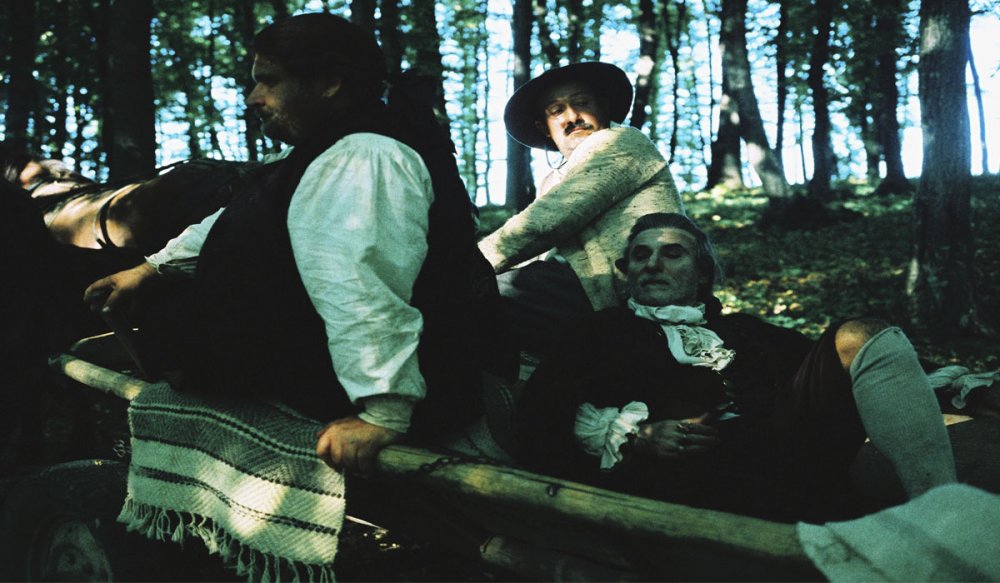
The Story of My Death (Història de la meva mort, 2013)
If you go to a film school and tell them, “If you hate the actors the film will be better,” or tell them “If you go against the cinematographer and cut 40 per cent of the image the film will be better,” or tell them “If you act as Warhol and start manipulating people, pitting them against each other, the film will be better” – no! They will never accept that. They think that film is done in an industry and everyone is facing the same direction. Obviously everyone has the intuition that a little bit of fighting puts some life in the images, but as a principle, not as ‘just a little bit’, as a principle of working.
And with digital cameras you can still keep the organicity of the ensemble, the whole team. This is one of the keys of my style. I can put this funny thing and this serious thing, and a spiritual approach and the ridiculous approach, but with a final organicity. The shooting is so wild and crazy, but in the end there is a closeness in the final product, an organic closeness. This force. Maybe my strength is to cloak the film in this organicity but still having inside some contradictions.
Would this organicity coming from a digital approach ever itself become a cliché, something you’d need to react against by, say, shooting on film?
No, it’s not possible with my way of shooting. It’s expensive, not useful and it’s very boring. For me, in the shooting, okay, I like violence and I like stress during the shoot, but it’s also a celebration of life, a moment of communion, a foundational moment of something, of creation. We cannot all work if we have big equipment, it’s 35mm, we have to wait because they think the film is shot, so we have to wait for the light, we have to move the cameras, we cannot follow what’s happening, if there’s something beautiful we cannot shoot it because everything has to be adapted to the equipment.
In my style, in my conception of life, the equipment always has to be adapted to what is in front of the camera, not the other way around. I have not come to this world to wait for a stupid technician to prepare lights. It’s the technician preparing lights who has to adapt to my light. So what do they do now? They shoot with a lot of light. They don’t care very much about the dramatic effects of light, they put a lot of light. The shoot on the Arri Alexa cameras with the big definition, and then they make everything in post-production. It’s so simple, it’s so easy. It’s so boring. It was not moving. Then, we can do it at home.
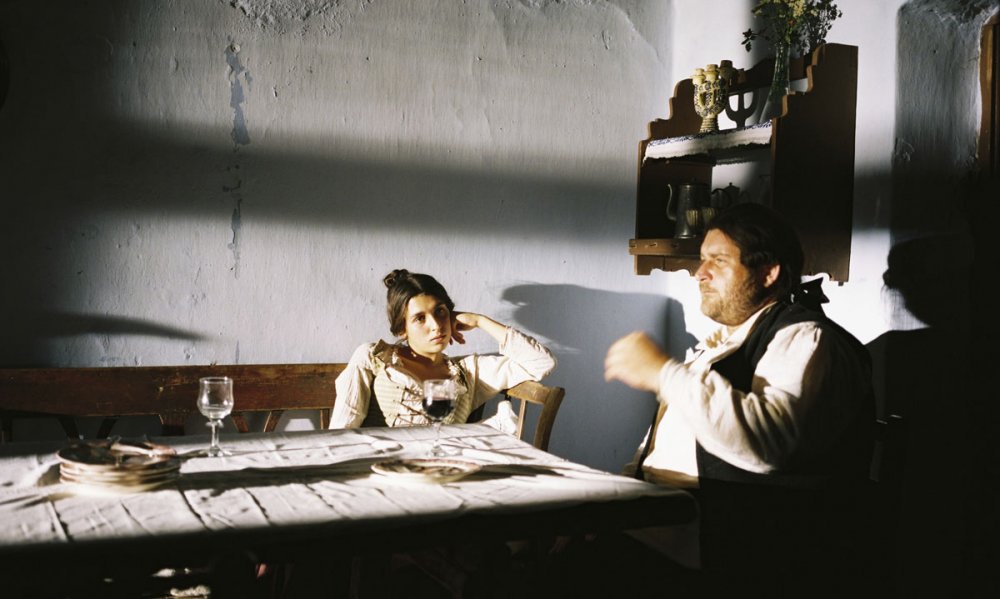
The Story of My Death (Història de la meva mort, 2013)
The technical equipment has to serve always all the other aspects of the film, has to be secondary, has to adapt to the needs of the inspiration, the inspiration of actors. In fact, it was Paul Morrissey and Warhol who had this idea, that actors are more important than anything. Actors used their faces. This was the essence of film in the 1930s, to put light in the face of the actor. Then, artists arrived. Not as technicians but creative guys. They said light could have a dramatic effect, create some sensation – “I am the artist, not the actor.” The decadence, in some sense, started with this idea. The actor losing the three-dimensional presence, all the other elements are two dimensions. And one day we forgot this is the one element that can create emotion.
In some sense, I’m still there. I really want to be there, the technique waiting for the inspiration, in a wide sense of the word, of actors. For nonprofessional actors, that means the technique always has to be ready, because you don’t know when inspiration will arrive, or where and in what form.
Is this why you shoot with multiple cameras at once?
Multiple cameras, yes. Visually, I like three. If you have more you cannot control as well, but two and three are okay. It depends on the scene, the conditions. With a digital camera, I can put a camera all the way on the other side of the room. You can make the image deeper. You can have a very close shot and the camera won’t disturb. With a 35mm camera you need to be close, prepare the lights, the camera is heavy, the camera needs someone making the focus: you need to prepare shots. I think of my film in terms of scenes and because of digital cameras I don’t have to think in shots. I can shoot this scene: “Okay, put the camera,” poom, poom, and “Let’s start!”
Is it important also to your non-professional actors to have such a minimal technical presence?
Of course. Without the invasion of the camera I can really follow the inspiration of the actors. What’s important is what’s in front of the camera, not what’s ‘behind’, in my mind. I am very sensitive to what is in front, what is happening.
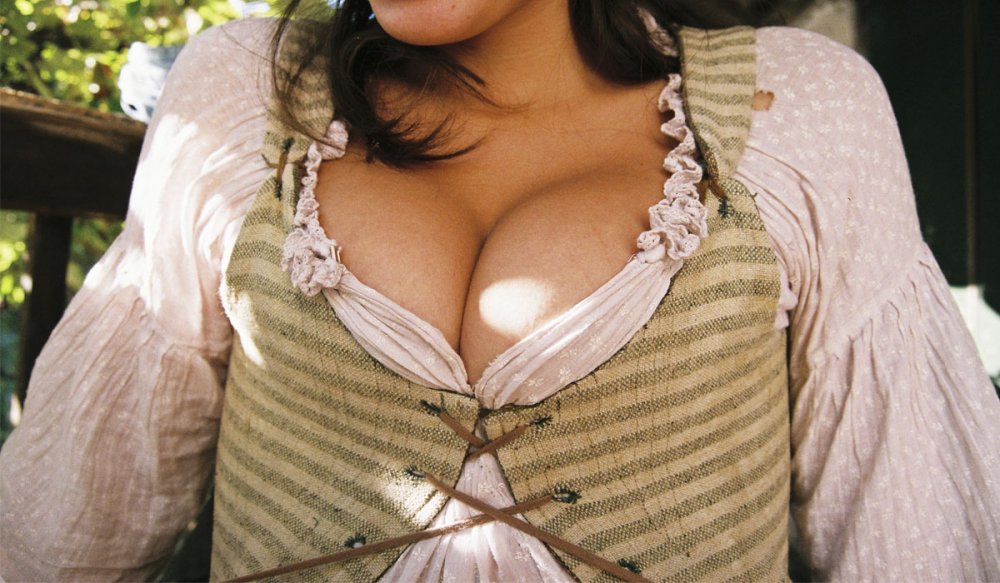
The Story of My Death (Història de la meva mort, 2013)
There are filmmakers who shoot with a camera and there are other filmmakers who shoot with a projector, projecting what’s in their mind – but a projector doesn’t record! Godard said that. The idea you have to shoot with a camera what’s in front, not your fucking ideas, your absolute ideas. This is Hollywood’s horrible style, in the worst sense of the word, they shoot all the ideas they had in their mind, the creative mind: you are the artist, so you have a lot of ideas, and they simply built in front what’s already built behind.
I am against that. I destroy what I have in the previous stage of the making of the film. I don’t trust my own ideas. I am prepared to go ahead with new ideas that go against the previous ones. I am really focused on what goes on in front. This is why I never use a monitor and check the image, because you lose the sensitive part of the work if you have a monitor. If you just look at what’s happening in front, feeling, having the atmosphere, whether it’s good or not, then the film is already done. I don’t have to do anything.
In Story of My Death, in all the scenes, the sex scenes which we shot more of than is in the final version, or in some violent scenes, I never saw any moment or any image of what we were doing. I simply heard what was happening. Maybe asking the producer or asking somebody else. But I never saw any moment, any image of what’s in front of the camera!
This is a new moment, a new step. It’s something I’ve been working on in my previous films. For example, the sound for the dialogue. I don’t like to listen to dialogue. It was the sound guy, who I trained working all the time with me, he made all my features with me, we found some kind of complicity, [he knows] my kind of taste, [he was] listening to the dialogues they made like this [makes thumbs up] or like this [makes thumbs down], if [he] thought the dialogue was working or not. The same idea: my ideas can destroy some inspiration, some moment, of the actors. I am preparing everything for inspiration for them. It’s very subtle to cut or to kill this inspiration.
This methodology allows you to get something very unique, but it also cuts the possibility of having the perfect final film. Because it’s too chaotic, simply too out of control. It’s difficult: the more elements you put [in], the more challenges you put on yourself, the more chaotic, unpredictable everything will be. It’s very difficult to challenge yourself all the time and ultimately have harmony. Harmony is linked to proportion and it requires some balance. You have to have this in mind and make a choice.
It’s a process I try to improve all the time, always being free and always having some control, it’s a paradox. You cannot be conscious and unconscious at the same time. If the essence of my work is to be unconscious, I really have to be unconscious, you cannot control it! Confusion isn’t a value in the final form of the film, but in the shooting it works. Everything is sacrificed to the final form of the film, even me, my egocentricity as a filmmaker, as the head of the shooting, everything is sacrificed to what we think is the best final form of the film. If you sacrifice others you have to accept that you can also be sacrificed as a filmmaker. You can fail, you can die, in some sense. Like a torero. A good torero is known for two or three great corridas. They make hundreds of forgettable afternoons.
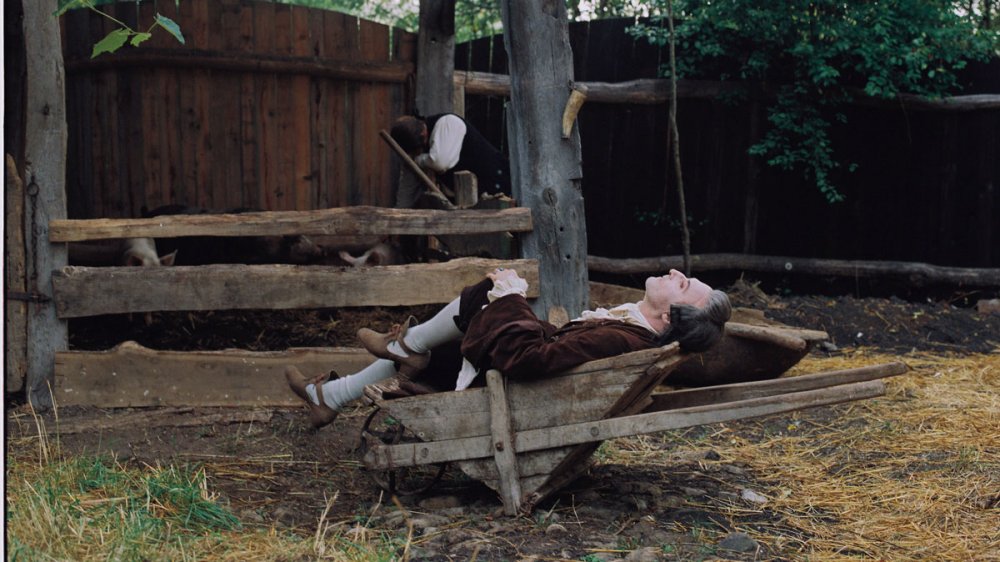
The Story of My Death (Història de la meva mort, 2013)
For me, the real magic justifies all the other things. Some small, real magic. I don’t want to make a correct film that is good in every aspect, perfect in some sense but does not have this fix. That’s the essence of magic: you need ups and downs. The peaks in a film require the valleys.
There’s a lot of risk and, I would think, anxiety in this hands-off approach.
Yes but I always work like this. But what do I have to see? It is nothing. The magic of film, the magic of my work, is not what you see. I can shoot it: you are the actor [gestures at my body], I’m not interested in what you are, it’s not interesting; but what do you have here [gestures in the space around me], what is here, what you have in mind, the sensation of what you are doing now while you are being shot, when this person crosses with this moment with this present, with what’s happening now… It’s not seen. It’s transparent. Maybe it will appear and say something in the final images. Why do I have to say something or look at you?
This is the essence of the first moment I decided to be a filmmaker. I was at a party when I was 24, it was a beautiful party, but it was a normal party, some drinks in the summer, some people from the countryside, some young people. But that moment created some kind of magic. Three minutes or four minutes of magic that was physical and spiritual, people making jokes and moving, a harmony. I said “What a beautiful thing! Maybe life should always be filled with this magic.”
And it’s collective. Not like when you are in love, which is personal, you are in love and everything is dreamy, the ambiguity of what is real and what’s in your mind, and you have this full sensation that is physical but also abstract. The same feeling, but collective. It happens sometimes! Then you stay with the same people, in the same place, with the same conditions – exactly the same – and… no magic!
After this first party I wanted to try to encapsulate, to control this magic. My question, which this is the essence of, is that if the camera shoots this day that is magical and shoots a day without magic, from a physical point of view it’s the same, same conditions, same people, will the camera record this? In our mind, the psychological difference between these two days is immense, huge. Will the camera be able to record this difference? Is there a visual difference that the camera will be capable of encapsulating?
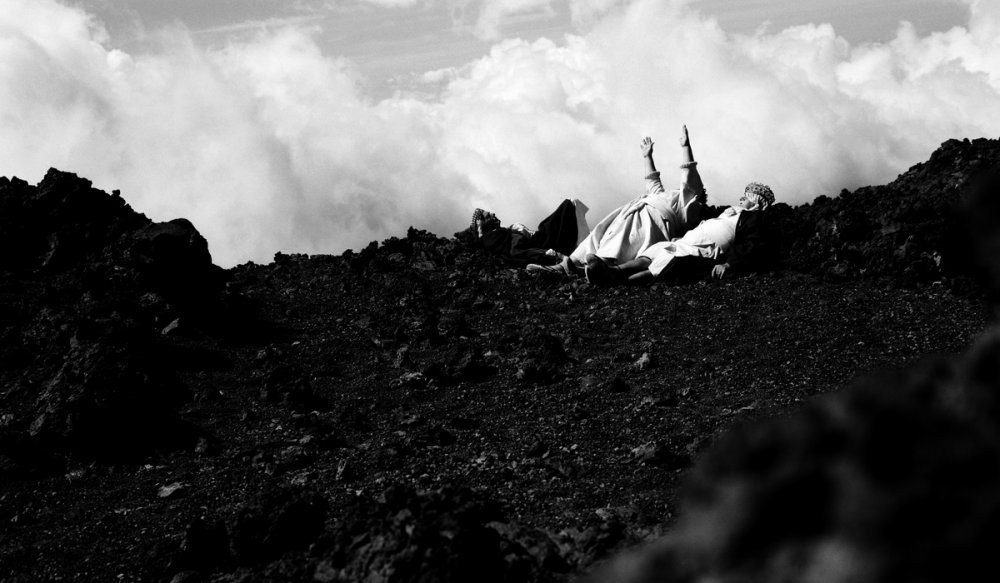
Birdsong (El cant els ocells, 2008)
My answer is: sometimes, yes! The magic is invisible. If it exists, the camera will record it. I don’t know if the camera will be so subtle [as] to have the capacity to discover this magic. I will discover it afterwards, studying the images. You can really make mistakes if you trust ‘you’; I trust the camera, not me. It’s a tension between what the camera records and what my mind records, whether it’s real or not real. The camera will only record what is real. In this way I cannot make misunderstandings, pretending something is real when it is not. It’s a tension. I have to give some freedom to the camera to exist, and also give some freedom to the possibility that this magic doesn’t exist.
Is it pure directorial strategy or is the magic also related to the subject of the film?
It’s linked with the mystery of the film, as we discussed in the beginning. I am shooting this way, this is my methodology, so mystery will always be there, with the actors, with the shooting. There’s a gap… If it’s not magic, it’s mystery. I always win, in some sense. It’s a desire for magic. One of the most mysterious things in the world, no?
I put the conditions in the shooting so that there will be something. You have to amplify, to help the camera to record it. Amplify, but not create it from nothing. It’s a complex process; it’s about intuition. I trust my way of working, and until now magic always appeared, and if not, there was mystery. So I am happy. We’ll see with the new challenge of a more explicit approach with the next film.
What is beautiful in this methodology is what I was talking about in terms of the closeness of the organicity. There are no small elements, only one big manipulation. It’s a world in itself. A visual world itself, caught in the camera. The real 3D images, without being visually 3D! Because all the other ways of shooting it’s the opposite, it’s going on simplification, flatness. This is a methodology that works for me, it’s good for me, I don’t say that it’s the way every filmmaker should work.
It’s also a methodology it sounds like you are always in the process of discovering.
It’s only possible when you are open-minded. Magic is always connected, in some sense, with communication with an audience, with people who are against you, or are in front of you, but who are not you. When making a film you are capturing a collective magic, but the only one who can see if it’s coming or if it’s there is the artist.
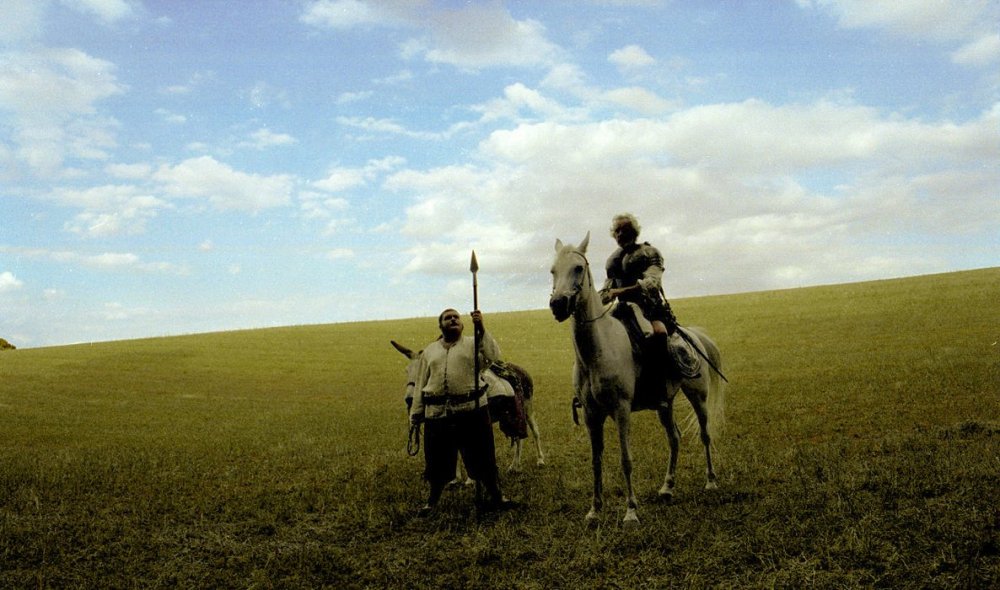
Honour of the Knights (Honor de Cavalleria, 2006)
Because it’s certified. It’s the reason he’s the artist and the others are the people who help the artist, because they cannot be so sure. They don’t have the talent to have the absolute faith the magic will appear. Absolute faith in my vocabulary means direct communication with God, in some sense. It’s a collective thing that happens there, but the one who sees it as through a transparent glass is the artist – but the experience is collective.
But maybe some can’t feel it, like you feel the magic of the party but one only spends one or two days afterwards thinking about it. This is the audience. But there is only one for whom this is central to his or her life, something that changes, he cannot go to work the same way, he has to react, has to make something, it changes his or her life. A sensation has consequences in the world: this is art.
What would happen, as we said at the beginning, if all cinemas showed Straub films? I’m not sure. It would be good, for sure. It would be very, very strange, if there were no other alternatives. And maybe people would start to change: their own lives, their way of perceiving things. But to do that it should be compulsory to control, a dictatorship of art. But now there is also a dictatorship, on the opposite side!
Maybe we can change things. It’s a utopia, maybe, but let’s check this utopia, that’s the point! Some say art is for the happy few; I like to think that. You don’t have many alternatives now; at least we have the happy few! Or the happy, happy, few, few, few, few! But cinema is a popular form of art, the moving images, so why not? I always work with that idea in mind, that someone who goes to my film will come out better.
-
The Digital Edition and Archive quick link
Log in here to your digital edition and archive subscription, take a look at the packages on offer and buy a subscription.




